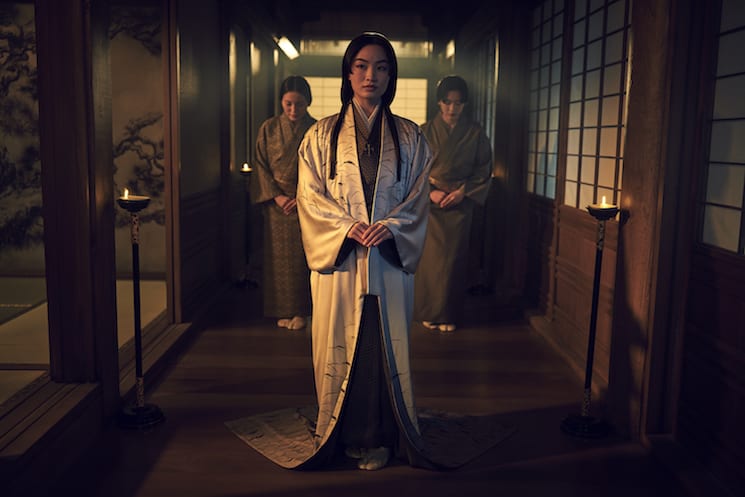Adapting any beloved novel to the screen is daunting, even more so when some of the book's themes are perhaps a little dated. James Clavell's Shōgun, first written in 1975, is one of these books.
The third instalment in the author's six-book Asian Saga, Shōgun tells the story of an Englishman who comes to Japan in the year 1600 and, through a combination of unwillingness to forgo his mission and willingness to adapt to his circumstances, ends up ingratiating himself with a local warlord. He becomes a close ally and advisor to the warlord, falls in love with Japanese culture and with a Japanese woman. Ultimately, he plays pawn, knight and witness to the warlord's rise to power.
An excellent book full of melodrama, action and court intrigue, and at over 1,100 pages, it's a difficult task to adapt the novel into anything other than a miniseries. In 1980, a faithful adaptation starring Richard Chamberlain was released; now, with some attempts (mostly successful) to update certain aspects of the novel, Clavell's novel is once again receiving the limited series treatment.
As in the novel, English navigator John Blackthorne (Cosmo Jarvis) arrives in Japan in 1600. As a Protestant, the Portuguese merchants living there immediately establish Blackthorne as an enemy, but the navigator manages to convince Kashigi Yabushige (Tadanobu Asano), Lord of Izu, that he's not his enemy.
After eventually meeting with Yabushige's superior, Lord Yoshii Toranaga (Hiroyuki Sanada), Backthorne is cleaned up and begins to learn about Japanese culture, primarily from the young woman assigned to be his interpreter, Toda Mariko (Anna Sawai).
At the same time, Toranaga is engaged in imperial court intrigue, attempting to manoeuvre himself in and out of various situations, punctuating the political machinations with occasional bouts of violence. The producers of Shōgun (including Sanada himself) pull out all the stops with casting; on paper, old men sitting around in rooms deciding the fate of the realm sounds boring, but this talented group of actors makes it compelling.
Sanada is his usual, reliably good self, as is Takehiro Hira in his role as Toranaga's chief rival Ishido, both men play the strong, stoic type with more going on in their eyes with great effect. Sanada comes to life in the scenes with Jarvis, as their characters size each other up and learn from one another — it gives both of them a chance to be a little freer, which makes their chemistry as friends feel genuine and earned. Additionally, a real standout is Asano as Yabushige. A man with more ambition than sense, Asano plays Yabushige with an infectious dumb-smart-guy energy and steals every scene he's in.
Anna Sawai has one of the more challenging roles in the series as Lady Mariko, who is caught between the pull of her loyalty to her master, Lord Toranaga, her Christian faith, her attraction to Blackthorne, and her duty to her neglectful husband. Sawai conveys inner turmoil beneath a stoic exterior quite well, and it helps that she spends so much time with Jarvis's Blackthorne, who brings out her emotions a little more.
As for Jarvis, he's simply fine as Blackthorne. Beginning the series doing what might be described as a passable Tom Hardy impression, Jarvis eventually grows into the part, especially as the character's appreciation of Japanese society grows.
For the most part, the series can be enjoyed without prior knowledge of the books, especially those who enjoy epic political intrigue. Conversely, one area that will alienate some fans of the novel is the story of John Blackthorne. In the novel, Blackthorne is unequivocally the protagonist. The reader follows his journey within the Japanese feudal court as he marvels at Japanese culture, falls in love with Mariko, and becomes a loyal friend and advisor to Toranaga.
This adaptation takes nearly the opposite approach, presenting the Japanese characters as the main focus and the struggle for power in the realm as the primary plot. This isn't a bad idea — we don't need a white character to teach us to appreciate other cultures as some perhaps did in 1975. The effect, though, is that Blackthorne's story could be entirely excised from this series without consequence, and it leaves the series feeling like it doesn't have a protagonist. His relationships with Toranaga and Mariko are essential in the book, but in this series, they are barely shown (especially the former), and almost all his character growth is developed off-screen.
That being said, the series contains many great performances and an excellent production design that make it worth watching. Everything from the costumes to the CG cityscapes feel as considered and authentic as possible, and for those of us who appreciate stage violence, this has its fair share.
Shōgun is a good show — but it sometimes feels like something is missing, and that something is holding it back from being great.
